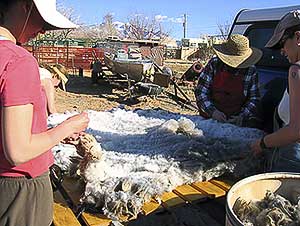Fleece
Although coating sheep usually produces the most vegetation-free fleece, there are many reasons why this shortcut method of producing vegetation-free fleece is not practiced on Cunnington Farms. Our main reason is for the comfort of our sheep in the extreme heat of the desert. We are located in Moab, Utah where daytime temperatures reach 112 in the summer, and night to day temperature vary enormously.

Vegetation can get into the fleece in a number of ways. Intermittently, we pay young people to feed our sheep, to get familiar with farm life and chores, and perhaps to induce them to try a little farming themselves when they grow up.
Since these folks are beginners at sheep care, they sometimes throw hay on the sheep, in addition to in the feed bins, and we often have much more vegetal matter in the fleece than we would wish. We recently installed new feeders which should help with the hay-on-the-head syndrome. However, the mills we send our fleeces to produce Roving and Yarns for us that are wonderously veg-free.
During shearing we again pay young people to help us skirt, so that they can get their hands in the wool and perhaps develop a yen for fiber.
All of this means that before we can send our fleece to the mill, we have many nights in front of the television, or on the phone, or watching the casserole cook in the oven, picking the majority of the vegetal matter out of the fleece by hand. This may be a time-consuming, tedious task, but the comfort of our sheep comes first.
(Being spinners, knitters and weavers ourselves, we know how much vegetal matter is “too much”, and strive never to offer a product with “too much” for sale.)

We breed registered Tunis, Navajo-Churro, Border Leicester & Romeldale/CVM sheep. We have also successfully bred stunning CVM, Merino, Corriedale, Icelandic and Border Leicester crosses, and have roving and yarn from these crossbred sheep, as well as yarn blended with our alpaca and guanaco, but not all products are available at all times.
